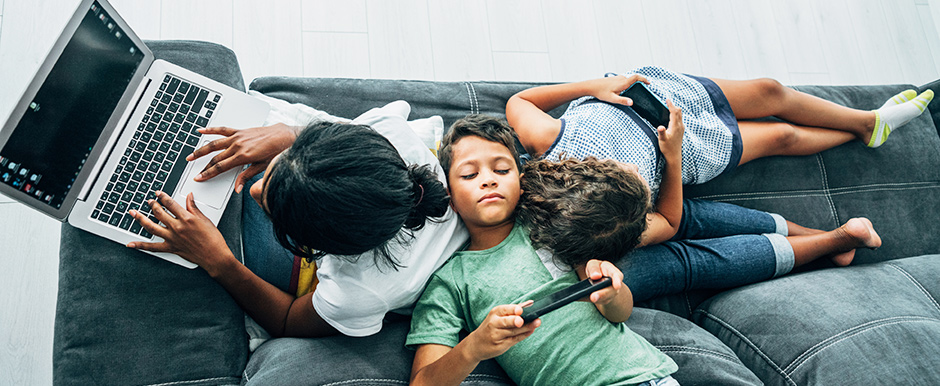Many of us know about the downside of social media. The recent documentary The Social Dilemma made some of us even more aware of the way that social media is designed to be addictive to its users. While many of us would like to have our children spend less time on digital media, it is not practical to take a complete digital detox, when so much of our learning and other activities are taking place online during the pandemic. Instead of focusing on reducing screen time, try balancing your child’s screen use by looking at the quality of content and engagement.
How can we help our kids balance screen time with other activities, and even help them with their own self-regulation around screens? Here are five suggestions:
-
Remember that “screen time” can be measured many different ways.
One way to consider “screen time” is to tally the actual time spent using or interacting with screens–phones, computers, tablets, and TVs. But, especially in these times, which basically require an increase in overall screen time, it may be more important to focus on the quality of the content, and the “how” and “who” of our engagement. For example, an 8-year-old who spends half an hour passively watching a famous ‘YouTuber’ play a video game has a very different experience from a child who spends that same half hour building new worlds in Minecraft or Facetiming or playing a game with a friend. Ideally, age-appropriate, interactive (mentally stimulating, educational, and/or socially engaging) screen time will greatly exceed passive or “mindless entertainment” screen time.
-
Try to help your child self-regulate.
It’s no fun to be the “media cop” and many parents seek advice about helping their kids self-regulate in this and other areas, to help them build their own life skills. Self-regulation of screen time will depend on your child’s age and executive skills development. Please keep in mind that executive functioning skills are not really fully developed until our mid-20s, so we need to be realistic about what we can expect of our kids! A younger child is simply not going to be able recognize that they’ve watched too much TV and turn it off independently. Self-monitoring and self-control are muscles that need to be taught and exercised. As parents, we can best support our kids with developing self-control and regulation around screen time by modeling it ourselves, having conversations with our kids to understand why they are engaging with particular media, and helping them reflect regularly on (or even track on a chart) how they feel after various amounts of time in front of a screen.
-
Set some ground rules when your child is having difficulty.
You will also likely need to establish consistent rules and expectations about acceptable screen use (ideally with some degree of input/collaboration from our child) so they have a limit that they are working to adhere to. It is best if you can start from a place of curiosity—try to gain understanding in order to gradually teach your child self-regulation. You may consider having ongoing family meetings about screen use and regularly spending time watching media together, in order to understand your child’s perspective and possible areas of compromise.
-
Try to set a good example yourself.
Keep in mind that kids learn from what they see, so we first need to try to model stepping away ourselves. Instead of reading a newspaper article online, consider purchasing the paper version. Instead of mindlessly scrolling through social media, go for a walk while catching up with a friend on the phone or Facetime. Try to make sure that your time (or your child’s) on screens has not begun to take away from other regular beneficial activities, such as exercise, spending time outdoors, connecting with friends and family, or completing chores. Consider scheduling in set “screen-free” times each day and even areas of the house that are “screen-free” (e.g., no screens at the breakfast or dinner table). Take regular breaks throughout the day from screens and involve your kids–perhaps take a 5 – 10 minute walk or play together outside after every hour of screen time.
-
Go easy on yourself.
The role of screens has changed and expanded for most of us during the pandemic. Screens have become more critical than ever for connecting with friends, family and co-workers, and have become the best option for making distance learning interactive and engaging. Kids (and adults) of all ages NEED opportunities for socializing and connecting “face to face” with others. This is of course an unusual and extremely stressful time for everyone, and screen time is one area in which we can certainly relax our standards about “how much/what is okay” and practice self-compassion. This is temporary and necessary. You’re doing the best you can with the ongoing situation, so please make sure you reduce your stress where you can by forgiving yourself (and your kids) for increased screen use!

